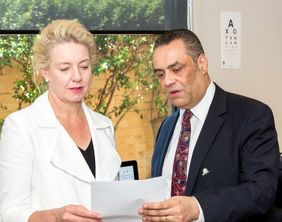 A significant step in securing a stable rural medical workforce Dr Ayman Shenouda A rural renaissance It is great to see the Federal Government delivering on its commitment to increase the number of rural-based doctors in training.What we are experiencing right now in rural health can only be described as a rural renaissance. We have great leadership in our Rural Health Commissioner and now in our new Rural Health Minister making her mark and building on the great work of her predecessor. More intern placements in general practice is great news for rural doctors and their communities. This is an essential step in securing the next generation of rural GPs by ensuring our trainees receive broad exposure through prioritising primary care and general practice. These programs really work as they provide trainees with that essential insight to community medicine. Intern rotations in general practice The Rural Junior Doctor Training Innovation Fund (RJDTIF) program provides primary care rotations for rurally based first-year interns. It builds on existing state and territory arrangements to provide primary care rotations in addition to hospital rotations. . Last week, Rural Health Minister, Senator the Hon Bridget McKenzie, announced a $1,304,967 Federal Government grant for the Murrumbidgee Local Health District to increase intern rotations throughout the region. I’m proud to be contributing with my practice in Wagga selected to participate and we will be rotating five interns a year through this program. It was great to show Minister McKenzie around my practice and have a chance to discuss how to provide that valuable community exposure early. The Minister showed a deep understanding of what is required in placing policy priority on general practice. She shared my vision that every junior doctor should have a rotation in general practice as part of the first two to three years of training. Quality training experience In our practice, we have GP specialists, new fellows, GP registrars, interns and medical students working alongside nurses and allied health professionals. We aim to support the integration of vertical and horizontal teaching enhanced through a multidisciplinary team environment. A strong teaching culture and established education networks also ensure we have the hospital and community partnerships to enhance exposure and demonstrate for our trainees the diversity of general practice. We’ve worked hard to build the required supportive infrastructure and systems to make this work which needless to say is also reliant on a solid business model. Keeping them there Targeted exposure strategies like these ensure trainees can develop the broad range of skills required. It provides essential rural exposure for interns to learn the complexities of delivering services in rural areas while in a supportive general practice setting. My own experience with the PGPPP where I had 12 interns rotated in my practice really yielded results. From that cohort, about 70 per cent of them have chosen general practice as their training speciality. They loved the diversity and complexity general practice offered. It challenged them, kept them engaged and provided that important insight into the doctor-patient relationship. A little on the policy journey Addressing maldistribution has been dominant in the discussion at many Rural Health Stakeholder Roundtables in Canberra over recent years. Certainly, greater exposure to general practice for junior doctors has been central to RACGP Rural advocacy around securing an integrated rural training pathway. Particularly in ensuring more emphasis on primary care and generalism early in medical education. But really making generalism a foundation of junior medical training – a discussion made more difficult on the back of a defunded PGPPP. This was a significant policy obstacle when you consider that what we were pursuing was more of a supercharged PGPPP but specifically for rural areas. We needed a solution that would boost the number of GPs as well as address the gap in the rural pathway by providing intern rotations in general practice and primary care. We knew there was a strong learner preference for rurally based internships. We also knew that potentially we had lost a cohort of potential rural GPs as the gap from the PGPPP hit hard and narrowed our opportunities. A win for general practice It certainly was a long policy process getting here. This is the why this program, which was the result of a long period of sustained advocacy, is such a significant win for general practice. It is clear much of the hard work over many years is starting to pay off particularly in rural health. This is a significant step forward in securing a stable medical workforce to address maldistribution.
1 Comment
|
Author
Dr Ayman Shenouda Blogs categories
All
|
